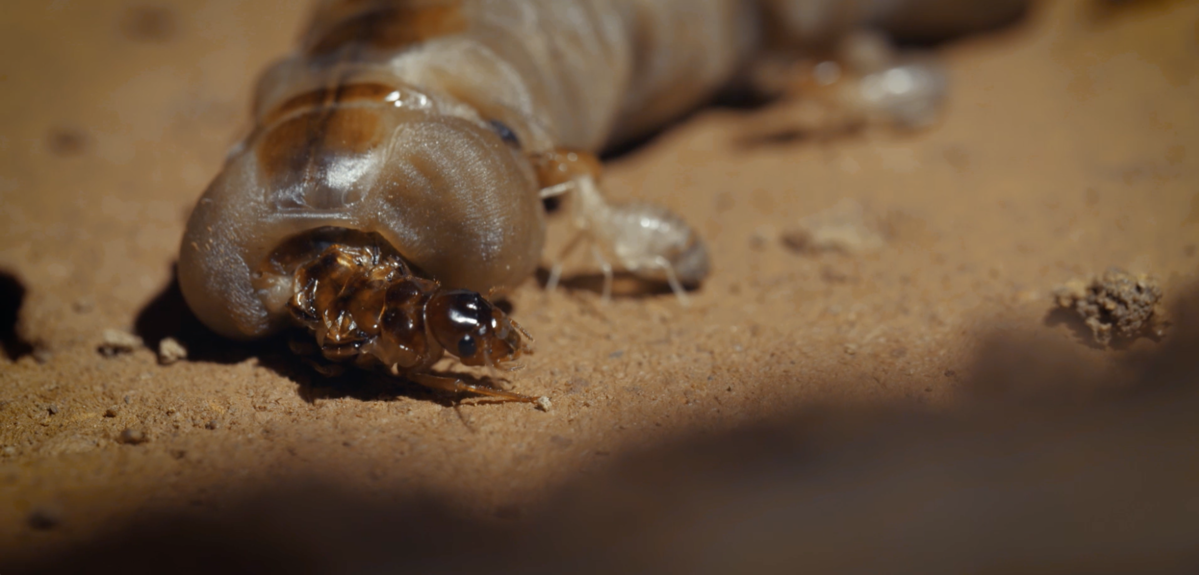You are here
Mysteries of the Termite Queen
Hidden from daylight, millions of workers toil on this immensely complex nest. Termites, insects often considered a nuisance, have occupied the soil of our planet for over 200 million years. Yet we still know little about their social structures. In order to study them, French researchers have traveled to the termites’ natural habitat, in South Africa.
For the last few years, this area near Pretoria, the nation’s capital, has hosted a team of biologists and entomologists directed by Mireille Vasseur-Cognet. In partnership with a local university, these scientists study the colonies of Macrotermitinae, a species of termite present in the region. It’s a particularly complex study because these insects are very sensitive to daylight and changes in temperature. In order to observe the interactions between the queen termite, her mate and the workers, the team of scientists has undertaken an ambitious project: not only are they studying a colony in its natural habitat, they’re also trying to create colonies in a laboratory. To do this, they must first delicately penetrate to the heart of the mound and remove its core: the royal chamber.
ITV Laure Anne
The goal for today is to capture the queen of this termite mound. There’s one queen per colony who is responsible for reproduction, essentially creating all of the workers and soldiers. The problem is that she’s somewhere in the mound but we don’t know exactly where. Here we see a partition that runs for 50cm, which is really hard, so we have to use a pickax to break through. But the queen’s quarters are quite fragile so we can’t just hit the insides until we find it. The quarters are the place where both the queen and king live, unlike what happens with ants or bees. So this is where they mate, where the eggs are laid, and also where the workers come to feed the queen as she’s locked inside. Her entire life will be spent in this room.
Once the royal lodge is extracted, the scientists only have a few hours to transport it to the laboratory. They begin the process of opening it, trying not to injure the queen. This fragile monarch occupies a special place in the insect world. Unlike workers and soldiers of the colony who only live for a few months, the queen can live for over 40 years.
Over the course of her life, she will lay over 40,000 eggs per day, regularly fertilized by her king. To study the secrets of this royal couple, entomologist Alain Robert creates pairings within the laboratory. In nature, winged termites fly away from their old colony once a year to mate and start a new nest. These scientists have recreated what’s called a copularium, the initial nest cell of the royal couple.
ITV Alain Robert
Once we introduce the two individuals within the box, immediately the male will find the female because she has a ventral gland that secretes a sexual pheromone. The two will begin constructing a copularium. They’ll isolate themselves completely, building walls from dirt mixed with saliva, and within a week the female will begin laying eggs. The main challenge is that there’s only a 10% success rate in the lab ; meaning we must manage a high mortality rate. We have to keep a certain number of males and females in stock and be ready to form new couples.
The French team in Pretoria has prepared over 800 copularium boxes to improve their chance of success. But to be able to observe the interactions between the royal couple and the workers, the researchers must displace a complete colony. A termite mound is not easy to conquer. Under the blazing sun, the scientists will spend many hours with their pickaxes before finishing their trenches. Entire sections of the mound must be collected without harming its thousands of inhabitants if they are to reconstitute a functional colony in the lab.
ITV David
In recreating the colony in the lab we have to keep it at the same temperature and humidity as in the field. We’ll also install a white light to recreate daylight and adjust it automatically in order to recreate nightfall. The idea is to observe the different behaviors of the king and queen in this mound that we’ve brought to the lab as well as the behavior of the workers and soldiers in relation to the royal couple.
In another room of the university, the termite mound takes on a new shape. The royal quarters have been separated from the rest of the colony in order to identify the individuals who enter. This is a crucial step, because the queen spends her entire life protected within this lodge, completely reliant on her workers for food. This food may be responsible for the queen’s exceptional longevity and fertility - that’s Mireille Vasseur Cognet’s hypothesis.
ITV Mireille
The king and the queen are masters of reproduction - they populate the whole colony, and they are both fed in the same way.
So we see morphologically that their development follows the same trajectory. But unlike the king, the queen is producing offspring her entire life, which is why she interests me more than the king. In comparing the two types of individuals on a molecular level, we can deduce what specifically leads to the development of the ovaries. We’re obviously also studying what drives the king’s similar longevity.
In order to observe these exchanges of food and identify the workers who are in charge, the scientists must establish a new protocol. It’s necessary to open the colony in the middle of the night to film the normal hustle and bustle of the royal quarters. The researchers have also brought a camera equipped for close-up photography, filming under a red light the insects can’t perceive. Over many hours, the camera will continuously film the comings and goings at the heart of the royal quarters. The next day, the team comes together to analyze these images. Despite the disturbance caused by the camera’s presence, interactions between the queen and the workers suggest trophallaxis, the exchange of food by regurgitation. In identifying the category of workers carrying out this exchange, the team hopes to uncover the molecular composition of this food and its impact on the queen’s longevity.
ITV Mireille
We’re particularly interested in the mechanisms that enable us humans to age well. We know diet plays a big role. At the molecular level, we already have a lot of information about humans. But we think can discover new interactions in the animal world that may translate to humans. By better understanding these molecular mechanisms, we may better understand how to improve our eating and thus our aging process.
This team’s research is only the beginning of exploration into this field. In the future, the study of these laboratory colonies and the interactions between workers and their queen could open new frontiers in medical research. And show once again, that the insect world hasn’t yet finished revealing its secrets.
Inside a Termite's Nest
The queen termite can lay some 40,000 eggs every day for 40 years. So what is her secret? A team of researchers from France and South Africa is trying to recreate a termite's nest in the lab to understand this incredible longevity.
David Sillam-Dussès (Université Paris 13)
Alain Robert (IRD)
Institut d'Écologie et des Sciences de l'Environnement de Paris (iEES-Paris)
CNRS / IRD / Université Paris-Est Créteil / INRA / Université Sorbonne Université / Université Paris Diderot
Laure-Anne Poissonnier (Post-Doc)
Qi Li (engineer)
Human Frontier Science Program





